Jiantao Jiao
How Do LLMs Perform Two-Hop Reasoning in Context?
Feb 19, 2025Abstract:"Socrates is human. All humans are mortal. Therefore, Socrates is mortal." This classical example demonstrates two-hop reasoning, where a conclusion logically follows from two connected premises. While transformer-based Large Language Models (LLMs) can make two-hop reasoning, they tend to collapse to random guessing when faced with distracting premises. To understand the underlying mechanism, we train a three-layer transformer on synthetic two-hop reasoning tasks. The training dynamics show two stages: a slow learning phase, where the 3-layer transformer performs random guessing like LLMs, followed by an abrupt phase transitions, where the 3-layer transformer suddenly reaches $100%$ accuracy. Through reverse engineering, we explain the inner mechanisms for how models learn to randomly guess between distractions initially, and how they learn to ignore distractions eventually. We further propose a three-parameter model that supports the causal claims for the mechanisms to the training dynamics of the transformer. Finally, experiments on LLMs suggest that the discovered mechanisms generalize across scales. Our methodologies provide new perspectives for scientific understandings of LLMs and our findings provide new insights into how reasoning emerges during training.
Token Assorted: Mixing Latent and Text Tokens for Improved Language Model Reasoning
Feb 05, 2025



Abstract:Large Language Models (LLMs) excel at reasoning and planning when trained on chainof-thought (CoT) data, where the step-by-step thought process is explicitly outlined by text tokens. However, this results in lengthy inputs where many words support textual coherence rather than core reasoning information, and processing these inputs consumes substantial computation resources. In this work, we propose a hybrid representation of the reasoning process, where we partially abstract away the initial reasoning steps using latent discrete tokens generated by VQ-VAE, significantly reducing the length of reasoning traces. We explore the use of latent trace abstractions in two scenarios: 1) training the model from scratch for the Keys-Finding Maze problem, 2) fine-tuning LLMs on this hybrid data with an extended vocabulary including unseen latent tokens, for both logical and mathematical reasoning problems. To facilitate effective learning, we introduce a simple training procedure that randomly mixes latent and text tokens, which enables fast adaptation to new latent tokens. Our approach consistently outperforms the baselines methods in various benchmarks.
How to Evaluate Reward Models for RLHF
Oct 18, 2024

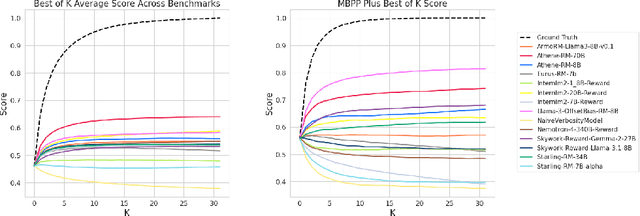
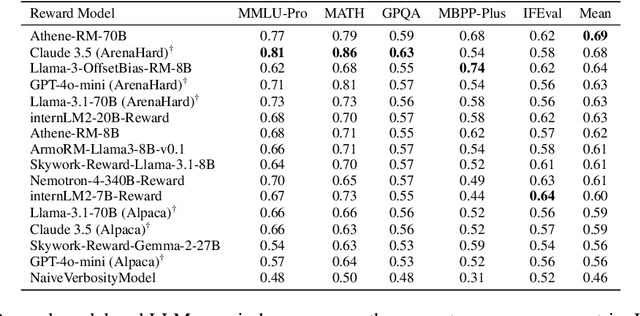
Abstract:We introduce a new benchmark for reward models that quantifies their ability to produce strong language models through RLHF (Reinforcement Learning from Human Feedback). The gold-standard approach is to run a full RLHF training pipeline and directly probe downstream LLM performance. However, this process is prohibitively expensive. To address this, we build a predictive model of downstream LLM performance by evaluating the reward model on proxy tasks. These proxy tasks consist of a large-scale human preference and a verifiable correctness preference dataset, in which we measure 12 metrics across 12 domains. To investigate which reward model metrics are most correlated to gold-standard RLHF outcomes, we launch an end-to-end RLHF experiment on a large-scale crowdsourced human preference platform to view real reward model downstream performance as ground truth. Ultimately, we compile our data and findings into Preference Proxy Evaluations (PPE), the first reward model benchmark explicitly linked to post-RLHF real-world human preference performance, which we open-source for public use and further development. Our code and evaluations can be found at https://github.com/lmarena/PPE .
Active-Dormant Attention Heads: Mechanistically Demystifying Extreme-Token Phenomena in LLMs
Oct 17, 2024



Abstract:Practitioners have consistently observed three puzzling phenomena in transformer-based large language models (LLMs): attention sinks, value-state drains, and residual-state peaks, collectively referred to as extreme-token phenomena. These phenomena are characterized by certain so-called "sink tokens" receiving disproportionately high attention weights, exhibiting significantly smaller value states, and having much larger residual-state norms than those of other tokens. These extreme tokens give rise to various challenges in LLM inference, quantization, and interpretability. We elucidate the mechanisms behind extreme-token phenomena. First, we show that these phenomena arise in very simple architectures -- transformers with one to three layers -- trained on a toy model, the Bigram-Backcopy (BB) task. In this setting, we identify an active-dormant mechanism, where attention heads become sinks for specific input domains while remaining non-sinks for others. Our theoretical analysis of the training dynamics reveals that these phenomena are driven by a mutual reinforcement mechanism. Building on these insights, we propose strategies to mitigate extreme-token phenomena during pretraining, including replacing softmax with ReLU and Adam with SGD. Next, we extend our analysis to pretrained LLMs, including Llama and OLMo, showing that many attention heads exhibit a similar active-dormant mechanism as in the BB task, and that the mutual reinforcement mechanism also governs the emergence of extreme-token phenomena during LLM pretraining. Our results reveal that many of the static and dynamic properties of extreme-token phenomena predicted by the BB task align with observations in pretrained LLMs.
Thinking LLMs: General Instruction Following with Thought Generation
Oct 14, 2024



Abstract:LLMs are typically trained to answer user questions or follow instructions similarly to how human experts respond. However, in the standard alignment framework they lack the basic ability of explicit thinking before answering. Thinking is important for complex questions that require reasoning and planning -- but can be applied to any task. We propose a training method for equipping existing LLMs with such thinking abilities for general instruction following without use of additional human data. We achieve this by an iterative search and optimization procedure that explores the space of possible thought generations, allowing the model to learn how to think without direct supervision. For each instruction, the thought candidates are scored using a judge model to evaluate their responses only, and then optimized via preference optimization. We show that this procedure leads to superior performance on AlpacaEval and Arena-Hard, and shows gains from thinking on non-reasoning categories such as marketing, health and general knowledge, in addition to more traditional reasoning & problem-solving tasks.
EmbedLLM: Learning Compact Representations of Large Language Models
Oct 03, 2024Abstract:With hundreds of thousands of language models available on Huggingface today, efficiently evaluating and utilizing these models across various downstream, tasks has become increasingly critical. Many existing methods repeatedly learn task-specific representations of Large Language Models (LLMs), which leads to inefficiencies in both time and computational resources. To address this, we propose EmbedLLM, a framework designed to learn compact vector representations, of LLMs that facilitate downstream applications involving many models, such as model routing. We introduce an encoder-decoder approach for learning such embeddings, along with a systematic framework to evaluate their effectiveness. Empirical results show that EmbedLLM outperforms prior methods in model routing both in accuracy and latency. Additionally, we demonstrate that our method can forecast a model's performance on multiple benchmarks, without incurring additional inference cost. Extensive probing experiments validate that the learned embeddings capture key model characteristics, e.g. whether the model is specialized for coding tasks, even without being explicitly trained on them. We open source our dataset, code and embedder to facilitate further research and application.
Meta-Rewarding Language Models: Self-Improving Alignment with LLM-as-a-Meta-Judge
Jul 28, 2024
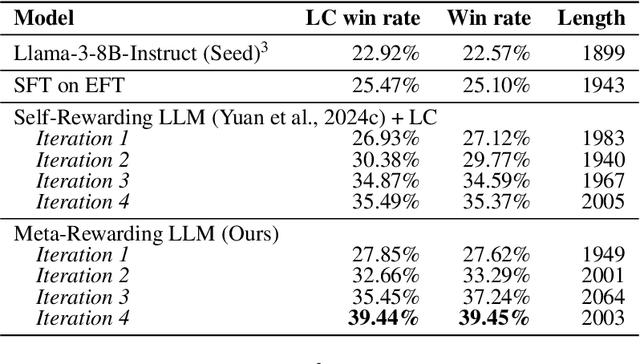
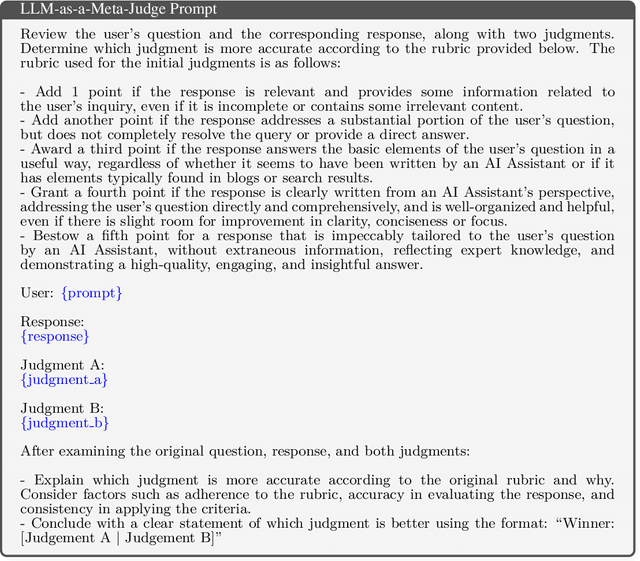
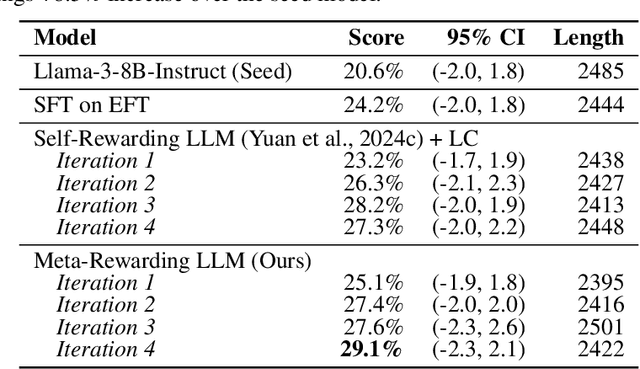
Abstract:Large Language Models (LLMs) are rapidly surpassing human knowledge in many domains. While improving these models traditionally relies on costly human data, recent self-rewarding mechanisms (Yuan et al., 2024) have shown that LLMs can improve by judging their own responses instead of relying on human labelers. However, existing methods have primarily focused on improving model responses rather than judgment capabilities, resulting in rapid saturation during iterative training. To address this issue, we introduce a novel Meta-Rewarding step to the self-improvement process, where the model judges its own judgements and uses that feedback to refine its judgment skills. Surprisingly, this unsupervised approach improves the model's ability to judge {\em and} follow instructions, as demonstrated by a win rate improvement of Llama-3-8B-Instruct from 22.9% to 39.4% on AlpacaEval 2, and 20.6% to 29.1% on Arena-Hard. These results strongly suggest the potential for self-improving models without human supervision.
Universal evaluation and design of imaging systems using information estimation
May 31, 2024



Abstract:Information theory, which describes the transmission of signals in the presence of noise, has enabled the development of reliable communication systems that underlie the modern world. Imaging systems can also be viewed as a form of communication, in which information about the object is "transmitted" through images. However, the application of information theory to imaging systems has been limited by the challenges of accounting for their physical constraints. Here, we introduce a framework that addresses these limitations by modeling the probabilistic relationship between objects and their measurements. Using this framework, we develop a method to estimate information using only a dataset of noisy measurements, without making any assumptions about the image formation process. We demonstrate that these estimates comprehensively quantify measurement quality across a diverse range of imaging systems and applications. Furthermore, we introduce Information-Driven Encoder Analysis Learning (IDEAL), a technique to optimize the design of imaging hardware for maximum information capture. This work provides new insights into the fundamental performance limits of imaging systems and offers powerful new tools for their analysis and design.
Toxicity Detection for Free
May 29, 2024Abstract:Current LLMs are generally aligned to follow safety requirements and tend to refuse toxic prompts. However, LLMs can fail to refuse toxic prompts or be overcautious and refuse benign examples. In addition, state-of-the-art toxicity detectors have low TPRs at low FPR, incurring high costs in real-world applications where toxic examples are rare. In this paper, we explore Moderation Using LLM Introspection (MULI), which detects toxic prompts using the information extracted directly from LLMs themselves. We found significant gaps between benign and toxic prompts in the distribution of alternative refusal responses and in the distribution of the first response token's logits. These gaps can be used to detect toxicities: We show that a toy model based on the logits of specific starting tokens gets reliable performance, while requiring no training or additional computational cost. We build a more robust detector using a sparse logistic regression model on the first response token logits, which greatly exceeds SOTA detectors under multiple metrics.
Toward a Theory of Tokenization in LLMs
Apr 12, 2024



Abstract:While there has been a large body of research attempting to circumvent tokenization for language modeling (Clark et al., 2022; Xue et al., 2022), the current consensus is that it is a necessary initial step for designing state-of-the-art performant language models. In this paper, we investigate tokenization from a theoretical point of view by studying the behavior of transformers on simple data generating processes. When trained on data drawn from certain simple $k^{\text{th}}$-order Markov processes for $k > 1$, transformers exhibit a surprising phenomenon - in the absence of tokenization, they empirically fail to learn the right distribution and predict characters according to a unigram model (Makkuva et al., 2024). With the addition of tokenization, however, we empirically observe that transformers break through this barrier and are able to model the probabilities of sequences drawn from the source near-optimally, achieving small cross-entropy loss. With this observation as starting point, we study the end-to-end cross-entropy loss achieved by transformers with and without tokenization. With the appropriate tokenization, we show that even the simplest unigram models (over tokens) learnt by transformers are able to model the probability of sequences drawn from $k^{\text{th}}$-order Markov sources near optimally. Our analysis provides a justification for the use of tokenization in practice through studying the behavior of transformers on Markovian data.
 Add to Chrome
Add to Chrome Add to Firefox
Add to Firefox Add to Edge
Add to Edge